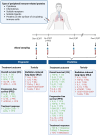The prognostic and predictive value of peripheral immune-related proteins in patients with lung cancer treated with radiotherapy
- PMID: 40746594
- PMCID: PMC12312015
- DOI: 10.3389/fonc.2025.1625212
The prognostic and predictive value of peripheral immune-related proteins in patients with lung cancer treated with radiotherapy
Abstract
Lung cancer is the leading cause of cancer-related death world-wide. Although the standard of care for patients with advanced stage lung cancer has significantly improved with the advent of immunotherapy and targeted agents, the overall prognosis remains poor. It highlights the need for improved patient selection utilizing prognostic and predictive biomarkers. Given the limited feasibility of serial lung tumor tissue biopsies, liquid biopsies have gained specific interest in achieving this aim. Radiotherapy, commonly used alongside systemic treatments, can induce the release of immuno-stimulatory and immuno-suppressive molecules, triggering the immune- and inflammatory responses and releasing associated molecules. This review specifically focusses on immune-related molecules that are measurable in the blood and which have potential prognostic and/or predictive value in patients with lung cancer treated with radiotherapy alone or in combination with systemic agents. Such immune-related molecules include cytokines and chemokines, damage-associated molecular patterns, soluble receptors and ligands, and proteins expressed on the immune cell surface of circulating immune cells. Classical cytokines IL-6, IL-8, and TGF-β1 were the most studied molecules in patients with lung cancer treated with radiotherapy and were associated with poor survival and increased risk of radiation-induced toxicity. To date, there are still some barriers before these promising findings can be implemented in regular clinical practice. Practical points to achieve this goal are also addressed in this review.
Keywords: biomarkers; immune-related proteins; lung cancer; peripheral blood; predictive; prognostic; radiotherapy.
Copyright © 2025 Lyu, Vaes, Laven, Cortiula, Hendriks, Vooijs and De Ruysscher.
Conflict of interest statement
FC reports outside of this manuscript personal fees as invited speaker from AstraZeneca, Roche, and Johnson & Johnson and as advisor to Regeneron and MSD; institutional funding as a local principal investigator PI from AstraZeneca and MSD; reports non-financial interests as member of the ESMO guideline committee on metastatic NSCLC. LH reports outside of this manuscript fees as an invited speaker from AstraZeneca, Bayer, Lilly, MSD, high5oncology, Takeda, Janssen, GSK, Sanofi, Pfizer, Medtalks, Benecke, VJOncology, Medimix; all payments were paid to the institution with the exception of Medtalks, Benecke, VJOncology, Medimix; fees paid to her institution for advisory board membership from Advisory boards: Abbvie, Amgen, Anhearth, AstraZeneca, Bayer, BMS, Boehringer Ingelheim, Daiichi, GSK, Janssen, Lilly, Merck, MSD, Novartis, Pfizer, Pierre Fabre, Roche, Sanofi, Summit Therapeutics, and Takeda; institutional research grants from Roche Genentech, AstraZeneca, Boehringer Ingelheim, Takeda, Merck, Pfizer, Novartis, and Gilead; institutional funding as a local principal investigator PI from AstraZeneca, GSK, Novartis, Merck, Roche, Takeda, Blueprint, Mirati, Abbvie, Gilead, MSD, Merck, Amgen, Boehringer Ingelheim, Pfizer, Daiichi, Amgen, and BMS. Member guideline committees: Dutch guidelines on NSCLC, brain metastases and leptomeningeal metastases, ESMO guidelines on metastatic NSCLC, non-metastatic NSCLC, and SCLC non-financial. Other non-financial: former secretary and current chair NVALT studies foundation, subchair of EORTC metastatic NSCLC systemic therapy, and vicechair scientific committee Dutch Thoracic Group. DR reports outside of this manuscript research grants from and support and advisor to: AstraZeneca, BMS, Beigene, Philips, and Olink institutional financial interests, no personal financial interests; Advisory board: Eli-Lily institutional financial interests, no personal financial interests. The remaining authors declare that the research was conducted in the absence of any commercial or financial relationships that could be construed as a potential conflict of interest. The author(s) declared that they were an editorial board member of Frontiers, at the time of submission. This had no impact on the peer review process and the final decision.
Figures


Similar articles
-
Systemic treatments for metastatic cutaneous melanoma.Cochrane Database Syst Rev. 2018 Feb 6;2(2):CD011123. doi: 10.1002/14651858.CD011123.pub2. Cochrane Database Syst Rev. 2018. PMID: 29405038 Free PMC article.
-
A rapid and systematic review of the clinical effectiveness and cost-effectiveness of paclitaxel, docetaxel, gemcitabine and vinorelbine in non-small-cell lung cancer.Health Technol Assess. 2001;5(32):1-195. doi: 10.3310/hta5320. Health Technol Assess. 2001. PMID: 12065068
-
The Black Book of Psychotropic Dosing and Monitoring.Psychopharmacol Bull. 2024 Jul 8;54(3):8-59. Psychopharmacol Bull. 2024. PMID: 38993656 Free PMC article. Review.
-
Cost-effectiveness of using prognostic information to select women with breast cancer for adjuvant systemic therapy.Health Technol Assess. 2006 Sep;10(34):iii-iv, ix-xi, 1-204. doi: 10.3310/hta10340. Health Technol Assess. 2006. PMID: 16959170
-
Systemic pharmacological treatments for chronic plaque psoriasis: a network meta-analysis.Cochrane Database Syst Rev. 2021 Apr 19;4(4):CD011535. doi: 10.1002/14651858.CD011535.pub4. Cochrane Database Syst Rev. 2021. Update in: Cochrane Database Syst Rev. 2022 May 23;5:CD011535. doi: 10.1002/14651858.CD011535.pub5. PMID: 33871055 Free PMC article. Updated.
References
-
- Girard N, Bar J, Garrido P, Garassino MC, McDonald F, Mornex F, et al. Treatment characteristics and real-world progression-free survival in patients with unresectable stage III NSCLC who received durvalumab after chemoradiotherapy: findings from the PACIFIC-R study. J Thorac Oncol. (2023) 18:181–93. doi: 10.1016/j.jtho.2022.10.003, PMID: - DOI - PubMed
-
- Passaro A, Wang J, Wang Y, Lee SH, Melosky B, Shih JY, et al. Amivantamab plus chemotherapy with and without lazertinib in EGFR-mutant advanced NSCLC after disease progression on osimertinib: primary results from the phase III MARIPOSA-2 study☆. Ann Oncol. (2024) 35:77–90. doi: 10.1016/j.annonc.2023.10.117, PMID: - DOI - PubMed
-
- National Comprehensive Cancer Network . NCCN Clinical Practice Guidelines (NCCN Guidelines ®) in Oncology for Non-Small Cell Lung Cancer Version 7.2024. (Plymouth Meeting, PA, USA: National Comprehensive Cancer Network (NCCN)) (2024). Version 7.2024. - PubMed
Publication types
LinkOut - more resources
Full Text Sources

